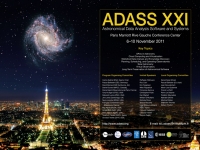Yoshiyuki Yamada (Kyoto University), Takuji Hara(National Astronomical Observatory Japan / University of Tokyo), Satoshi Yoshioka (Tokyo University of Marine Science and Technology), Yukiyasu Kobayashi (National Astronomical Observatory Japan), Naoteru Gouda (National Astronomical Observatory Japan), Hisashi Miyashita (IBM Tokyo Research Laboratory), Yoichi Hatsutori (IBM Tokyo Research Laboratory), Uwe Lammers (European Space Astronomy Centre, European Space Agency), Daniel Michalik (Lund Observatory, Lund University)
Abstract
The core data reduction for the Nano-JASMINE mission is planned to be done with Gaia's Astrometric Global Iterative Solution (AGIS). Nano-JASMINE is an ultra small (35 kg) satellite for astrometry observations in Japan and Gaia is ESA's large (over 1000 kg) next-generation astrometry mission. A collaboration between the Gaia AGIS and Nano-JASMINE teams on the Nano-JASMINE data reduction started in 2007. AGIS is a well-designed software and the part for treating raw data is separated from the core processing. The Nano-JASMINE team writes codes to generate AGIS input, and this is called Initial Data Treament (IDT). Because Nano-JASMINE is a very small satellite, there is no photometry detector, no star mapper, and no on board catalogues. So, the cross-matching of stars and colour index for astrometric correction should be considered in IDT. In the crossmatching process, we need to identify what object each observed stellar images is coming from. Also Nano-JASMINE has two fields of view and we should identify which FOV the observed image comes from. We surveyed some catalogues and UCAC2 is the most appropriate one as a reference. Centroiding is also considered. Because the detector is different from Gaia's detector, the window size is also different, Centroiding for Nano-JASMINE will be separate a task. We compare some statistical values for evaluating the photo centre from 5x9 small stellar image windows with 1/100 pixel accuracy. For converting centroiding results on detector to the celestial sphere, we need orbit and attitude data of the satellite. In Nano-JASMINE, orbit information is derived from on board GPS data and attitude is processed from on-board star sensor data and on-ground Kalman filtering. We also show the Nano-JASMINE goals, status of the data publications and utilizations, and introduce the next Japanese space astrometric mission.Paper ID: P164
Poster Instructions
|

